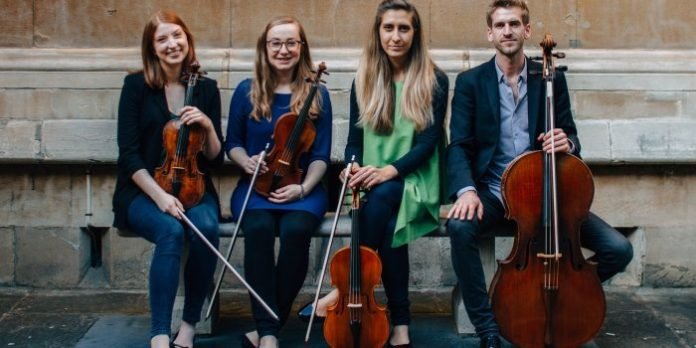The British string quartet Consone performed its very first concert in North America at Christ Church Cathedral on February 17.
Launched professionally in 2015, Consone is the first string quartet playing period instruments to be selected as ‘BBC New Generation Artists.’
When she introduced the program, the quartet’s Elitsa Bogdanova spoke of the melodic nuances achieved when gut is used for the strings of her viola, George Ross’s cello, and Agata Daraškaite’s and Magdalena Loth-Hill’s violins. The delicate harmonies that followed more than confirmed her observation.
The concert began with Mozart’s String Quartet No. 13 in D minor, KV173, published in 1773. Its opening measures were delivered as gracefully as a blue heron stepping from its nest into a cloudless sky. However, Mozart’s usual tuneful melodies were conspicuous by their absence. Instead, he manipulated and repeated fragments suggesting a familiar deja vu.
Joseph Haydn’s String Quartet in E flat major, Op.33 no.2 “The Joke,” published in 1781, offered some sublime moments, too, particularly in its Largo sostenuto section. Consone made a delicious meal of Haydn’s joke finale, with no less than seven false conclusions, until the program’s first half ended on a ‘happy note.’
The second half opened with Joseph Bolougne’s Quartet in G minor, op.1 no.3, also published in 1773. Consone played just two of Bolougne’s four sections, flashing a momentary taste of what could be mistaken for Early Music before slipping into its classical/romantic style.
Fanny Mendelssohn’s enchanting String Quartet in E flat major concluded the concert.
Originally written in 1834, the piece wasn’t published until over 150 years later because of the prevailing discriminatory attitude toward women in the Victorian era. Ironically, Fanny died at age 41 from complications of a stroke while rehearsing an oratorio published by her more celebrated younger brother Felix.
It’s a known fact that Felix, with Fanny’s permission, published many of her pieces under his name. Not this one, though.
It began strongly. The second section, familiar to many, was light-hearted and upbeat, contrasting the third (Romanze) with its undercurrent of turmoil and pain. Her final Allegro molto vivace begged an encore, graciously supplied by Consone with another gem by Haydn. Small wonder that he was commissioned by Austrian royalty. Indeed, it would be appropriate to say that the entire evening was filled with music fit for a king… or queen.

